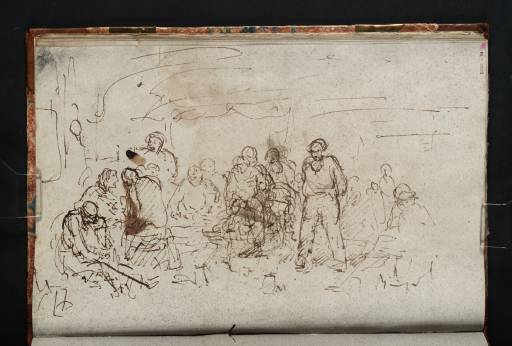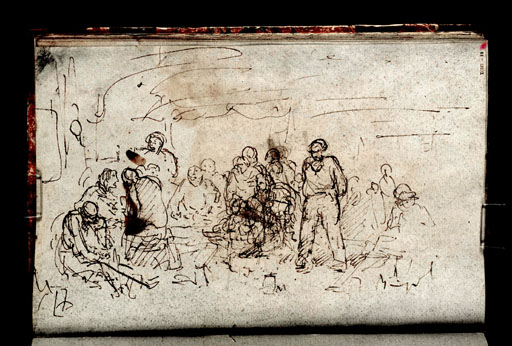Joseph Mallord William Turner Figures in an Interior c.1805-7
Image 1 of 2
Joseph Mallord William Turner,
Figures in an Interior
c.1805-7
Joseph Mallord William Turner 1775–1851
Folio 23 Recto:
Figures in an Interior circa 1805–7
D05802
Turner Bequest XCIII 23
Turner Bequest XCIII 23
Pen and ink and brown wash on white wove paper, prepared with a grey wash, 171 x 262 mm
Inscribed by John Ruskin in red ink ‘23’ bottom left, descending vertically
Stamped in black ‘XCIII 23’ bottom left, descending vertically
Inscribed by John Ruskin in red ink ‘23’ bottom left, descending vertically
Stamped in black ‘XCIII 23’ bottom left, descending vertically
Accepted by the nation as part of the Turner Bequest 1856
Exhibition history
1989
Turner and the Human Figure: Studies of Contemporary Life, Tate Gallery, April–July 1989 (72).
References
1909
A.J. Finberg, A Complete Inventory of the Drawings of the Turner Bequest, London 1909, vol.I, p.243, XCIII 23, as ‘Study for a figure subject’.
1974
Martin Butlin, Andrew Wilton and John Gage, Turner 1775–1851, exhibition catalogue, Royal Academy of Arts, London 1974, p.64.
1989
Ann Chumbley and Ian Warrell, Turner and the Human Figure: Studies of Contemporary Life, exhibition catalogue, Tate Gallery 1989, pp.58–9 reproduced.
1993
David Hill, Turner on the Thames: River Journeys in the Year 1805, New Haven and London 1993, pp.140, 141 reproduced pl.197 as ‘A Tavern Disputation’, 164, as ‘Distressed labourers’.
See Introduction to the sketchbook and note to folio 22 verso (D05801) for its various studies of (mainly rustic) figures. Here as in 22 verso the figures are in an interior. Taking his cue from Finberg’s description of folio 25 verso (D05807) as ‘Figures in distress’, and perhaps from then fairly recent art-historical trends,1 Hill associates these collectively with rural unrest, poverty and ‘a figure composition with a radical socio-political theme’. However, there is considerable variety in the actions and settings depicted in the various drawings and the mood seems sometimes more comic-grotesque than tragic. Finberg himself described the figures in folios 23 verso and 24 verso (D05803, D05805) as ‘carousing’. 23 verso probably depicts the harvest being brought in to Cassiobury Park – perhaps the ‘last load’ before the harvest feast that Turner drew elsewhere and started to paint (see Sketchbooks and Drawings Connected with Cassiobury Park and Harvest Pictures for the Earl of Essex circa 1807–12). This at least would not have been a time of misery.
Hill describes the present drawing as a ‘meeting of men, possibly at a tavern’ and (assuming Turner was working backwards in the sketchbook at this point) as a development, with 24 verso, of 25 verso, a ‘scene of desperate rural poverty’. He draws attention to figures speaking or shouting, while others ‘sit gloomily or gloweringly’ or thrust hands in pockets ‘in frustration’. He suggests the influence of pictures by George Morland exhibited in 1805 at Macklin’s Great Room, Fleet Street, and his scenario would also be reminiscent of David Wilkie’s Village Politicians shown at the Royal Academy in 1806 (private collection). A different possibility, that this scene is on board a ship, is suggested in pencil annotations to a copy of Finberg in Tate’s Library. To the present writer this seems if anything more plausible than the distressed peasant theme, as the walls and ceiling are curved and the timbers resemble bulkheads while a standing figure looks like a trousered sailor. Turner certainly took the sketchbook on a trip down the Thames (see Introduction).
David Blayney Brown
October 2007
How to cite
David Blayney Brown, ‘Figures in an Interior c.1805–7 by Joseph Mallord William Turner’, catalogue entry, October 2007, in David Blayney Brown (ed.), J.M.W. Turner: Sketchbooks, Drawings and Watercolours, Tate Research Publication, December 2012, https://www


